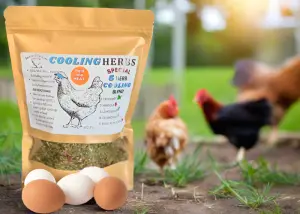
Stop wasting your time picking your hard boiled eggshells off in tiny pieces. Not preparing them “just right,” will not only waste your time, but half the egg too.
After reading through these hacks you will know how to easily peel hard boiled eggs, never dreading doing it again! Combine more than one hack and it will make it even easier for you to peel your eggs. How you prepare the eggs before peeling them is what is key.
#1 Wash Eggs Under Lukewarm Water

Washing eggs in lukewarm water prior to boiling them helps to remove the protective coating or “bloom” from the egg and opens the pores. With the pores open, you can add baking soda OR salt to the water which will aid in pulling the membrane away from the shell. (#2 and #3)

Nesting Box Herbs
- Increases egg laying naturally.
- Improves chicken health.
- Deters parasites: mites, lice, fleas & flies as well as mice, rats, raccoons, coyotes, opossums and more!
- On SALE!
- SHOP Nesting Box Herbs
Using lukewarm and not cold water is important. Cold water will make the contents of the egg contract, drawing in any bacteria from the outside surface of the egg. Warm water will make the contents expand, pushing any bacteria that may be in the pores of the egg out.
#2 Add Baking Soda to Boiling Water

Adding baking soda when hard boiling fresh eggs will help to raise the pH inside the egg, loosening the inner membrane from the egg white, making it easier to peel.
Instructions: Add 1/2 tsp of baking soda for each quart of water and gently place your eggs into the boiling water. Baking soda is more alkaline, with a pH level of 8.3. It will be drawn in through the pores of the egg, helping to raise the pH inside of the egg. This will help pull the inner egg membrane away from the egg white, making it easier to peel!
- The average pH of a freshly laid egg is about 6.0.
- The pH will gradually go up during storage, until it reaches a pH of about 9.5.
- Eggs stored in a refrigerator will take longer to reach a pH of 9.5.
- Baking soda is a base, with a pH level of 8.3.
- Adding baking soda, or sodium bicarbonate, when hard boiling eggs will help to raise the pH inside the egg.
OR
#3 Add Salt to Boiling Water
Add 1/2 tsp of salt per quart of water and gently place your eggs into the boiling water. By adding salt to the water, the proteins in the egg white solidify quickly, making them much easier to peel.
Adding salt to boiling water will also help to seal up any cracks in your eggs. This will minimize any egg white leaks into the pot of boiling water.
DO NOT ADD BOTH BAKING SODA AND SALT TO BOILING WATER. CHOOSE ONE OR THE OTHER.
#4 Add Eggs to Already Boiling Water

Adding eggs to already boiling water will do two things:
- Allow you to better manage the amount of cooking time.
- The egg membrane is less likely to stick to the egg white. With skipping the warm up period in water, the egg whites have less time to bind to the membrane.

Soft, Medium and Hard Boiled Egg Cooking Times
| SOFT BOILED EGGS | MEDIUM BOILED EGGS | HARD BOILED EGGS |
|---|---|---|
| COOK 6-7 MINUTES | COOK 8-10 MINUTES | COOK 10-12 MINUTES |
| LIQUIDY YOLK | SOFT, CREAMY YOLK | FIRM YOLK |
| IDEAL OVER TOAST OR IN A CUP | IDEAL OVER SALADS | IDEAL FOR DEVILED EGGS, POTATO SALAD, EGG SALAD SANDWICHES |
#5 Give Hard Boiled Eggs an Ice Bath

Giving the eggs an ice bath will shock the eggs, stopping them from cooking any further. It will also cause the egg whites to contract, pulling it away from the membrane, making it easier to peel.
Step 1: Cook eggs for 6-12 minutes, depending upon your wanted consistency.
Step 2: Remove from water and immediately place them into a cold bowl of water and ice or “ice bath.”
Step 3: Keep the eggs in the ice bath for a full 10 minutes, making sure that they cool completely.
#5 Shake Hard Boiled Eggs in Container
STEP 1: Remove your hard boiled eggs from the ice bath.
STEP 2: Place eggs in a container with a lid. You can use the same pot you boiled the eggs in or use a mason jar. If you are using a mason jar, you will have to add just a few eggs at a time.
STEP 3: Gently shake the container with the eggs inside for about 5-7 seconds. This will break the egg shell into little pieces.
STEP 4: Peel the eggs. The membrane should pull away from the egg white very easily and in large pieces. If you are lucky, you might be able to pull the entire shell off all at once! In any case, the eggs should be much easier to peel.
OR
#6 Roll Hard Boiled Eggs on Counter
If you don’t like the egg shaking method, you can simply take a hardboiled egg and gently roll it on a hard surface.
STEP 1: Remove hardboiled eggs from ice bath.
STEP 2: Place egg on a hard surface, such as a cutting board or your countertop.
STEP 3: Gently tap the fat end of the egg on the hard surface, making it crack.
STEP 4: Lay the egg flat on the surface. Applying light pressure, gently roll the egg back and forth. Do this until it has cracks around the entire egg.
STEP 5: Starting from the fat end of the egg, peel the eggs. The membrane should pull away from the egg white very easily and in large pieces. Just like with the shake method, the membrane should pull away from the egg white easily and in large pieces.
#7 Peel Under Running Water Method
After you cracked your eggs using either the “container shake” or “rolling on a hard surface” method, sometimes you may need a little additional help removing the stubborn egg shells. Try running the hard boiled egg under cool water while you are peeling it.
This can help release the membrane from the egg white, making it easier to peel.
#8 Spoon Method
If you find that it is still difficult to pull the egg membrane away from the egg white, try using a spoon. Slide the cupped end of the spoon under the membrane and slide it around the egg white, pulling it away from the membrane.
#9 Use Older Eggs
“Older eggs are easier to peel because they are less acidic than a freshly laid egg. The lower the pH level within the egg, the more difficult the egg will be to peel. In a freshly laid egg, the pH level is about 7.7, and the egg white is firmly attached to the inner shell membrane. As an egg ages, it absorbs oxygen and loses carbon dioxide. This causes the pH level to rise to about 9.2, making it easier to peel.”
“Why are older eggs easier to peel?”
According to the CDC, in order to avoid contamination, all eggs must be used within 2 hours of removing them from your refrigerator. If the indoor temperature is 90 degrees or higher, they must be used within 1 hour.
#10 Steam Eggs in Instant Pot Using “5-5-5” Method

Using the “5-5-5” method with the Instant Pot is an simple way to make a large quantity of easy to peel, hard boiled eggs!
STEP 1: Add 1 cup of water to the bottom of your Instant Pot.
STEP 2: Place a metal egg trivet on bottom of the pot.
STEP 3: Place eggs on top of the trivet. It’s ok to stack them. Pile as many eggs as can fit in there!
STEP 4: Pressure Cook for 5 MINUTES (Make sure the valve is set to sealing and not venting.)
STEP 5: Let the eggs do a Slow Release for 5 MINUTES.
STEP 6: Release the rest of the pressure.
STEP 7: Immediately place eggs in an Ice Bath for 5 MINUTES.
STEP 8: Use either the “Container Shake” or “Rolling on a Hard Surface” method to crack the eggs.
STEP 9: Peel with ease!
#11 Blow a Hard Boiled Egg Out of Its Shell (TikTok Sensation)
This trick involves taking a hard boiled egg and actually blowing it out of its shell! You can go on TikTok and watch numerous of hilarious videos of people doing this.
It takes a good set of lungs to be able to use this method though. Be careful, eggs can go shooting out doing it this way.
STEP 1: Tap and crack both ends of the hard boiled egg. Remove about a dime size hole on both ends.
STEP 2: Gently roll the egg on a hard surface until the egg shell is cracked all around.
STEP 3: Cup the egg with both hands.
STEP 4: Place your mouth over the smaller end of the egg.
STEP 5: Blow HARD. It can take quite a bit of lung power to pop the egg out!
CONCLUSION: How to Easily Peel Hard Boiled Eggs
Step 1: Bring pot of water to a boil. Add enough water to be able to cover eggs, when added, 1 inch.
Step 2: Wash eggs in lukewarm water.
Step 3: Gently add eggs to already boiling water.
Step 4: Stir in baking soda OR salt.
- The baking soda will be absorbed through the pores of the eggshell and raise the pH, helping to detach the inner membrane from the egg white.
- The salt will help the proteins in the egg whites to solidify more quickly, making them easier to peel.
Step 5: Cover eggs and remove from heat.
Step 6: Let eggs set, covered for 6-12 minutes, depending upon your desired consistency.
STEP 7: Drain hot water from eggs and immediately place the eggs into an ice bath for 10 minutes.
STEP 8: Use either the “Shake in Container” or “Rolling on Hard Surface” method to crack your hard boiled eggs.
STEP 9: Peel the eggs. Pull the membrane until the entire shell is removed from the egg.
Other Methods to Help With Peeling:
- Starting at the fat end of the egg, use a spoon to help pull the membrane away from the egg white.
- Run the cracked, hard boiled egg under cool water while you are peeling it.
- Use older eggs.
- Steam eggs in an Instant Pot.
- Blow the eggs out of their shells.









